#anthony antonio helicopter
Explore tagged Tumblr posts
Text
#talkin#tik tok#op#huncho619#anime#one piece#luffy#monkey d. luffy#zoro#roronoa zoro#chopper#tony tony chopper#anthony antonio helicopter
46 notes
·
View notes
Text
You were always on my mind
Summary
An innocent question from Muriel about Crowley's sketch of the Mona Lisa leads to an unexpected reaction from Aziraphale, and allows the angel and demon to talk about a past they do not share.
Notes
The characters of Leonardo and Salaï are based on their characterization in Assassin's Creed: Brotherhood.
On Ao3
Rating G - 1494 words
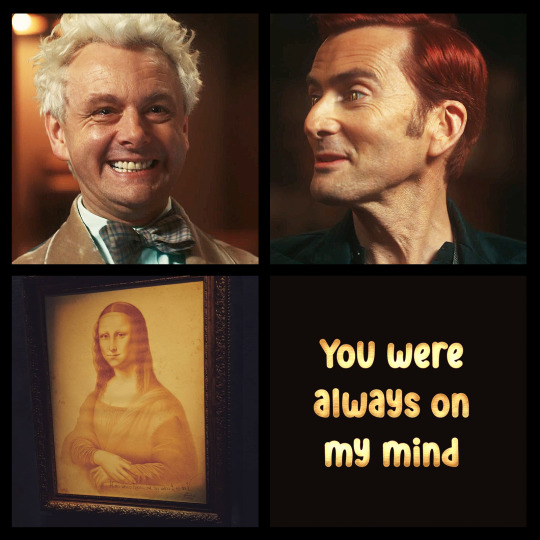
"Crowley?"
The demon, who was watering his plants, turned to Muriel and saw that they were standing in front of his precious sketch of Leonardo da Vinci's Mona Lisa.
As he approached, Muriel turned to him and, pointing to the painting where the inscription read, "Al mio amico Antonio dal tuo amico Leo da V." they asked, "Were you really friends with Leonardo Da Vinci?"
Neither of them saw Aziraphale, who had stopped to put away a book in order to listen to Crowley's answer, for he himself knew nothing of the origin of this friendship.
He had seen the inscription "To my friend Anthony". But he had chosen to ignore it, or rather to ignore the odd feeling it aroused in him.
Leonardo and Crowley sat across from each other over a drink, both quite intoxicated, but still lucid enough to talk.
Crowley looked around at all the sketches of the same woman, then pointed to one hanging on the wall and said, "That one, that's the best, even better than the finished painting.
He pointed to the canvas on the easel.
Leonardo rested his head on his hand and replied, "I got her bloody smile right in the cartoons, but it went all over the place when I painted it. Her husband had a few things to say about it when he was in yesterday, but, like I told him, Signor del Giocondo, apart from you, who's ever going to see it?"
Crowley chuckled, "Well said! Leo, if it's all right with you, I'd like to buy this from you."
The demon pointed to the sketch pinned to the wall and added, "I'll give you eleven florins for it."
Leonardo shook his head and said, "Antonio, canaglia! I want twenty!"
"Fifteen!"
Leonardo held out his hand and replied, " Deal. Now, explain this helicopter thingie again, win you?"
Crowley shook his hand and explained.
"Wow. And what was he like?"
Crowley replied with a gentle smile, "An interesting guy, much more open-minded than people of his generation, and way ahead of his time even before I told him a few secrets. The kind of person you don't forget."
Aziraphale briskly closed the book, causing Muriel and Crowley to turn at the noise. Then, pretending not to see them, he put the book down and returned to his desk, feigning concentration on a manuscript while seething inside.
He hadn't liked the look on Crowley's face when he had spoken of his "friend." He hadn't liked it at all.
Crowley and Muriel had continued to chat in front of the painting, but Aziraphale tried not to pay attention, and soon, lost in his thoughts, he didn't notice that Muriel had come out.
"Angel?"
Aziraphale tried not to show his distress as he turned to Crowley.
The demon continued, "Maggie asked me to give you this."
He showed him a plate with a slice of apple pie and continued, "She said she made it for you to thank you for your little arrangement. How about a little break with a cup of tea?"
Crowley was so thoughtful that Aziraphale felt even worse for being consumed by jealousy. He nodded and followed Crowley to the round table, avoiding looking at the painting as he passed.
He sat down at the table where Crowley had placed the plate and a steaming cup of tea. The demon sat down not far from him, a mug of coffee in his hands.
Aziraphale avoided his gaze and took a spoonful of cake. The cake was delicious, but given his state of mind, Aziraphale had to force himself to show his appreciation.
Crowley, not fooled, frowned and asked, "Angel, is something wrong?"
Aziraphale said hesitantly, "You never told me about your friendship with Leonardo Da Vinci."
"Oh, that? Well, you see, Angel, sometimes so much time passed between our meetings in the past that, amidst all we had to say and do, there wasn't room to cover it all. I had come to Florence for some temptations, but, as usual, the ingenuity of human beings in matters of sin surpassed me, and I found myself here with nothing to do. One evening, in a tavern, I made the acquaintance of his assistant, Salaï, who told me that I had the type of figure his master liked to draw, and dragged me to Leonardo's studio. And after that evening, when I bought the sketch of the Mona Lisa, we met again several times to drink and talk, he was much more enlightened than his contemporaries, clever and an excellent artist as well as a good drinking companion".
Aziraphale, growing increasingly annoyed, replied, "And besides, he knew your name was Anthony, or should I say Antonio."
He couldn't hide the bitterness in his voice and Crowley noticed and asked him bluntly, "Are you by any chance jealous, Angel?"
Aziraphale didn't answer and looked away.
"Angel?" insisted Crowley, who had moved closer.
He grabbed the Angel's chin, forcing him to turn his head toward him, and said softly, "Because if you are, you should know that you have no reason to be jealous. Leo was already involved with someone."
Azirapahel replied in a sulky voice, "But you liked his company."
Crowley replied in an amused tone, "For the reasons I told you. I even told him about you."
"Don't make fun of me, Crowley!"
The demon protested, "I'm not laughing at you. Just listen. The love of his life was his assistant, Salaï, which is ironically short for the Italian word "saladino," meaning "little devil." Which he was, by the way. He really had Leo wrapped around his little finger.”
"Leonardo, I'm going to have a few drinks with my friends, don't wait up for me tonight!"
Salaï blew him a kiss before closing the door behind him to the sound of the artist's light laughter.
Crowley turned to him and asked, "Is there a... special bond between you and this brat?"
Leonardo shook his head, "He's just my assistant."
Crowley raised an eyebrow and replied, "If he were just an assistant, you wouldn't have to specify, mio amico."
Leonardo took a sip of wine before replying quietly, "My past has taught me to keep those aspects of my life, private."
Crowley replied gently, "You need say no more."
Leonardo smiled and replied in a cheeky tone, "You know my biggest secret, tell me something about yourself, Antonio."
Crowley waited a few seconds before answering, also smiling, "There's this person, he's annoying at times, we're very different and don't often agree, but he's the only person I feel close to and have absolute trust in. We're a bit like two sides of the same coin, and it's only on the edge that we can meet."
"Then what are you doing here?"
"Huh?"
"Antonio, mio amico, what are you doing here with me?
Crowley didn't answer and Leonardo continued, "La vita senza amore, non è affatto vita. A life without love is no life at all. It doesn't matter what kind of love it is, maybe you don't know, but if it's the only person you feel close to, that's who you should be with."
"You see, Angel, you have no reason to be jealous, he even sent me to you. He probably saw the nature of my feelings for you long before I did."
Still holding the angel's chin between his fingers, he leaned over him and pressed a tender kiss to his lips. Then, pulling back a little, he continued, "You know, even when we haven't seen each other in centuries, you've always been in my thoughts. Especially since Job, there has been this other someone who went with his side as far as he could. Like me. Alone together, but aware of each other, so not quite so alone."
Aziraphale smiled and, placing his hand on the demon's cheek, said softly, "I'm sorry for my irrational jealousy.
Crowley shook his head and, leaning into the angel's hand, replied gently, "There is nothing to forgive. If anything, it's rather flattering. But more seriously, it shows us that there is so much we don't know about each other."
"You're right, and after hearing what you just told me about him, I'm glad you had a friend like that."
This time it was Aziraphale who leaned in to give Crowley a gentle kiss, and when he pulled away, he had a cheeky grin on his face as he said, "And thanks to that, I can boast that I'm the owner of the only bookshop to have an authentic Da Vinci hanging on one of its walls."
They both laughed, then the angel picked up his spoon and resumed enjoying his slice of apple pie while the demon took a long sip of coffee.
Their unoccupied hands sought each other across the table, intertwining their fingers.
They looked at each other, smiling knowingly, aware that they had cleared another small hurdle.
Just talking and listening.
Learning together.
_________
Still not beta'd
Still not my native language
Still hoping you'll enjoy this story 🥰
Still thanking you for bearing with me 😝
Ineffable Growing Love series : here (After season 2)
Ineffable Husbands masterlist : here (Before season 2)
#good omens#aziracrow#ineffable husbands#ineffable boyfriends#aziraphale#crowley#good omens fanfiction#aziraphale x crowley#crowley x aziraphale#GOS2Spoilers#leonardo da vinci#mona lisa
54 notes
·
View notes
Text
AU where Maria Stark was Good (But Maria Carbonell was Better)
TW: brief mentions of alcohol and abuse.
Maria Stark gave birth on May 29th. It was stormy outside. There was a lot of thunder. She loved it. Howard was outside. He wanted to know if it was a boy. Maria said that it was a beautiful baby boy, Antonio. Howard snorts. “Anthony,” he announces. And the nurses write that down instead. This is his first mistake with newly-christened Anthony.
Maria is expected to still keep the house clean and care for a child and do all sorts of charity auctions and still keep her figure. It’s exhausting. She hates it. So Jarvis steps in to help. He keeps the house clean and cares for Tony, the shortened version that Maria will accept because it is not Anthony, if she ever organizes charity events and needs to keep her figure. What a joke.
Howard is never around. She always figured that he was never ready for children. But he wants to pass the company down. So they had a baby. Maria was excited: a little baby to hold and influence. A baby to teach and cuddle and coo at. A little one to watch grow up and fret over. Perhaps a boy that would be innovative and bright and kind.
Howard wants none of that. He does not pay attention the baby. He holds “Anthony” at seven months and Tony cries for the five minutes. Howard immediately hands him back. Maria frowns. “He’s your son, Howard.”
“I have work, Maria.” It is always work.
Obadiah Stane comes in to give the baby gift. It’s a small set of tools for the tyke. “So he can start building our troops back up,” Obie says with a wink. “Looking ravishing as ever, Maria.” Maria has always hated Obadiah. He is not what he appears to be. She’s caught him in Howard’s office once or twice. She can’t prove anything, but she’s making sure that when Tony turns 21, he is never getting the reigns to that company ever.
Howard starts drinking. It isn’t so bad at first. It’s just more than she’s seen. It takes a turn for the worse when he tries to hold Tony and nearly drops him. Maria screams. He hits her cheek. Maria stares at him in disbelief.
She packs up her things the next day and moves out. She hires a lawyer while there’s still time. She knows it only gets worse from there. She had to see her Aunt Sofia go through the same ordeal. Insist that her husband loved her, he just got into moods. He didn’t.
The divorce happened quickly. She bruised easily. It made all the headlines. Stark Industries tanked. She got a quiet payout to never mention it again. She took the payment. Mentioned it all over again whenever she could. Maria changed her name to Maria Carbonell. She was cast out of society for mentioning a problem. Tony Carbonell came with her. So did Jarvis.
Tony grows up not being shunned. His mother sings him Rosemary Clooney in the kitchen. He meets the other side of the family. People look down on their family for having a single mother. Maria doesn’t care. “No matter what, don’t let anyone else’s opinions dictate what you’re going to do,” she says firmly. “No one can ever truly take away who you are, Antonio.” Jarvis nods at this whenever he visits.
He gets straight A’s. He grows up to be quite social, nice, and always inventing new things to help society and the general public. He starts working at a restaurant at sixteen to help out with the bills and such (Maria put almost all the money in a college fund and backup fund, and they live in a nice little apartment) and meets many people. He’s a natural talker, a talent he gets from his mother.
He gets into the most prestigious school around New York. SHIELD Academy. Maria frets about it. She’s worried. Like a mother would be. She walks him to the first day. “Mama, I’ll be fine,” Tony says, rolling his eyes. “You’re embarrassing.”
“A mother can’t be worried about her own son?” Maria asks him. “Are you saying that I shouldn’t be concerned? That I shouldn’t be a good mother?” She lets out a little smile as Tony whines.
“No, Mama...” She nods. Tony walks with her. She kisses him on the cheek. He hisses that she’s embarrassing.
“You love me anyway, Antonio. Call when you need a ride, huh?”
“Mama, you have work until five tonight. I’ll take the subway.”
“You know I don’t trust the subway.”
“And you know that you can only miss so many days of work.” Maria nods. He will take the subway. He got the stubbornness from Howard. Everything else from her.
By the end of the day, he’s telling her everything over dinner. (He cooked, she stayed at the office late.) He joined band, he joined the quiz team, he joined the chess team, and he’s thinking of being the mascot as well.
“Doesn’t the band play at the games?” Maria asks. Tony shrugs.
“I’ll figure it out, Mama. I always do.”
He eventually plays the trombone by cutting a hole in the mascot’s mouth. People think it’s hilarious, a bit weird, and Maria can proudly say that her son is both the mascot and plays an instrument besides.
They call her in for a conference. While he is a bit of a talker, that isn’t the thing that they want to talk to Maria about. It’s the fact that there’s a national competition, funded by Pym Industries. Maria is reluctant to admit that this could be a good thing--the event would be in upstate New York. There’s the possibility of him running into Howard. (She’s let him meet Howard once or twice--Tony did not like him much.)
She bids him goodbye at the bus stop. Waves hello at his new friend, Rhodey. He seems like a nice boy.
“You’re Tony’s mother?” A lady comes up to her. She’s wearing a very gorgeous lavendar dress.
“Are you Rhodey’s mother?”
They have tea and lunch. Maria and Roberta become lifelong friends, much to the bane of Rhodey and Tony, who don’t get away with nearly anything now that their mothers are friends.
The Pym trip ends up being good for Maria and Tony. She picks up a new thing--embroidery. Peggy Carter also visits. She meets Tony, and they become friends as well. Tony learns to celebrate everyday with careful consideration, and that he does not want to inherit Stark Industries at twenty-one if Howard is still living and he doesn’t have absolute say over what they’re doing.
He comes back with an injured puppy and puppy eyes. “It’s coming out of your bank account,” Maria warns him. “We are not keeping her.”
Her name is Dorothy after she gets her feet tangled up in Maria’s thread and can’t get it off. They keep her because despite Maria’s tough attitude, she’s a sucker for dogs.
Rhodey and Tony both get full rides to MIT. Roberta and Maria cry. They learn how to not turn into helicopter parents and talk to each other about how Rhodey isn’t eating anything but pasta and pizza, already on his way to gain his freshman fifteen (pounds) if not for the ROTC training, and Tony doesn’t remember to eat often enough.
“What a pair of geniuses we have raised!” Roberta writes Maria. Maria laughs, and writes back. She embroiders a new pillow to put in Tony’s dorm room to embarrass him. (Yes, she is a troll.)
Tony meets a boy in college. He’s afraid of what his mother will think. He’s afraid of what everyone will think. Rhodey finds out first after Tony gives Steve a quick kiss goodnight after they went for pizza.
“Out of all the guys, and you pick Rogers to have at your door?” Rhodey says. “I would’ve gone for Barnes, personally.” Tony shrugs. He’s trying to pretend like he’s not vibrating with relief because Rhodey doesn’t care.
He writes to Maria. Finds that it’s easier. Mama visits him.
“Antonio,” she says softly. “I love you no matter what. And you know that. I am your mother, not your dictator. I do not get to decide who you love.” Tony cries. He hugs his mother.
Roberta insists that Steve come to Sunday family dinner at least once to see if he meets standard requirements.
Steve does. Rhodey lays into him. Terrence Rhodes laughs at a joke Steve makes about pie. He is easily accepted into the family. Jarvis even cracks a smile as Steve helps wash the dishes. “At least we know Antonio will be in good hands,” he murmurs to Maria. “Your son is quite messy.” Maria smacks him on the arm, but smiles. It is good to see her son so happy.
Rhodey meets a girl named Carol. She’s tough, resilient, and laughs at all of his stupid rocket science jokes. Tony loves her already.
Tony inherits Stark Industries at twenty-one after Howard dies in a freak car accident. (There are suspicions, but no one wants to say anything upfront.) Tony takes the reigns. He shuts down weapons manufacturing.
“I am Tony Carbonell, not Tony Stark,” he says. “I am not my father, nor have I ever been.” Stane is spitting mad. Orders an assassination attempt.
It barely misses his heart.
Maria feels like it goes through hers.
Tony is in the hospital. They bring in Dr. Ho Yinsen, who talks her into an experimental treatment. They’re putting a temporary reactor into his heart. Based off of Howard’s design. The only good thing he does for his son.
They power it on palladium. It’s only a temporary, year solution.
Tony designs a new element. He makes headlines. It’s called Carbonellium. Jarvis cries at the young boy, who acts like he hasn’t just revolutionized the world.
Steve proposes after they graduate from college. It’s symbolic only: it’s still illegal to get married in New York. They still have a ceremony. Carol is the flower girl, much to her amusement. Jarvis is the ringbearer.
Steve and Rhodey are in the military. Tony cries. Maria looks on. “He will be okay,” Maria murmurs. “You know Steve. He is too stubborn to die.”
“Too stubborn to give up either,” Tony reminds her. They wait.
Steve sends him letters. Tells him as much as he can. Says he misses Maria’s meals, they were so good. Asks Tony how business is going. Says he misses him dearly. Tony keeps every single letter. He sends Steve care packages and little gadgets in the mail.
Barnes gets sent home. His arm...there is nothing left. Tony nods. Makes sure that Barnes gets the proper help, and a newly designed arm. There’s nothing like it.
He releases plans to help people who are missing limbs. People can walk again. Get prosthetics for a lower cost and higher technology use. Tony studies the ways humans move. Anticipates things with Barnes. Writes Steve every day, even if his day was super boring.
Steve surprises him. He never told Tony when his leave was--he did two tours. He comes home while Tony is at Maria’s apartment, singing Rosemary Clooney and Nat King Cole. Steve hums along, smiling as Tony doesn’t even notice until he turns around and drops a sandwich on the floor.
Maria shrieks as she gives her son-in-law a hug. “You’re back!” Steve laughs. He had gotten flowers for her, a kiss for Tony. Maria smacks him on the arm. “Don’t you ever come back home when I am in my bathrobe again!” Steve laughs.
“I’ll try not to, Ms. Carbonell.”
Steve and Tony move into a house that has a white picket fence, a garden in the back for Tony and Steve to work on, and a kitchen that Tony swears he’s going to fix up. (He does.)
Steve paints it up all nice. They ignore the stare of neighbors and laugh when Carol and Rhodey buy the house next to them.
Carol and Rhodey’s daughters and son visit frequently. Rupert shows interest in art, which Steve can help with. He was studying to become an art teacher, but the army always did have a draw for him. Helena wanted to be just like Roberta Rhodes and work as a seamstress. (Roberta did a little bit of side work, and Helena loved it.) Riri was the anomaly: adopted as a baby, it appeared she was following the footsteps of Rhodey and Tony. She wanted to be a mechanical engineer. Rhodey and Tony marveled at her ideas of a powered suit of flight. “So I can fight bad dudes,” she says seriously. “Like the power rangers.” (She loves the power rangers.)
Maria smiles at her life. She is getting old; her bones creak, her muscles are not what they used to be. But she has led a good life. Her Antonio has had a good life. She fears what would have happened if she had stayed.
Maria Stark would have been a good mother--but Maria Carbonell is infinitely better.
#listen i love the fics where maria is a good mom#i just love them#so i decided to write one#look at how healthy tony is mentally#like he still eats ramen 24/7 but he was not screwed over by his parents#also i love the idea of mama rhodes and mama carbonell being good friends
84 notes
·
View notes
Text
Canines in the Service of Maritime Security
[By MLE2 Anthony M. Ross, USCG]
The United States Coast Guard has a long history of military working animals. During the early years of World War II, German spies landed on East Coast beaches and enemy subs were sighted on East and West coasts. These incidents led to the establishment of Coast Guard beach patrols and, by August 1942, the first Coast Guard dog was on patrol. During the war, 2,000 dogs participated in beach patrols alongside their Coast Guard handlers.

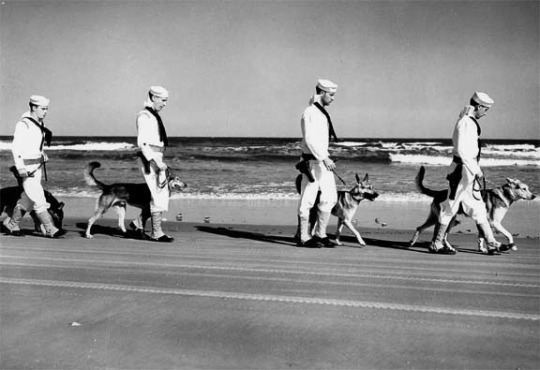
Coast Guard canines conduct beach patrols during World War II
In the 1990s, there were several Coast Guard canine teams in service. These teams were located at Station Sandy Hook, New Jersey, and Station South Padre Island, Texas, and used mainly for narcotics detection. In addition, there was a narcotic detection canine stationed at the Law Enforcement Detachment (LEDET) in Miami, Florida. Over the years, the Coast Guard’s narcotics detection canine program has remained relatively small. Normally, Coast Guard units find narcotics on the order of hundreds of pounds. With drug quantities of this scale, there’s no need for a dog, because humans can visually locate the drugs.
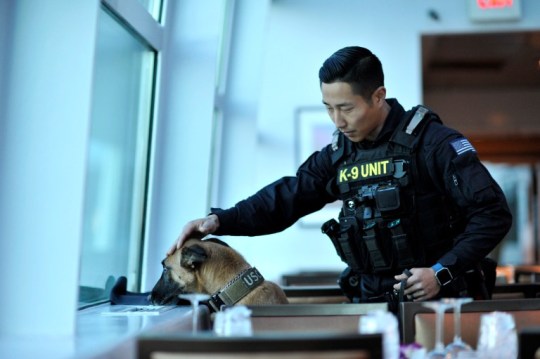
PO2 Richard Bacone from Maritime Safety and Security Team New York conducts a security sweep with his canine, Ruthie, during a dinner cruise in Washington, D.C., Jan. 19, 2017 (USCG)
As new mission threats have evolved, the Coast Guard’s canine team capability has also evolved. The modern Coast Guard Canine Explosive Detection Program was initiated as a result of the September 11th terrorist attacks. The Coast Guard was tasked with a variety of Maritime Homeland Security missions, which included high-capacity vessel safety and security for cruise ships and ferries and the best tool for this job is an explosive detection canine team. Due to the canine’s unique ability to detect even the smallest amount of explosives, Coast Guard units could effectively screen vessels before and after they left port. Thus, the modern Coast Guard Canine Program was born.
The service’s preference of dog breed for law enforcement and substance detection mission has changed through the years. During World War II, the Coast Guard used mostly Doberman Pinschers; however, like other military branches, the Coast Guard often received dogs from civilians who gave up pets for the war effort. Therefore, the service used a variety of breeds for its beach patrol in the early days of the program. The breeds first used in the modern Coast Guard Canine Program were Labrador Retrievers; however, as the science of canine capabilities has progressed, the service has added specific breeds, such as German Shepherds, Belgian Malinois, German Short Haired Pointers and Vizslas.
Coast Guard canine handlers are also a special breed. Candidates must be Maritime Enforcement Specialists of the highest caliber with an enlisted rank of at least a second-class petty officer. Members that apply must receive a positive endorsement from their commanding officer and a thorough screening by headquarters. Selectees must also dedicate six years to the service to ensure they are committed to the demands of this highly sought after position.
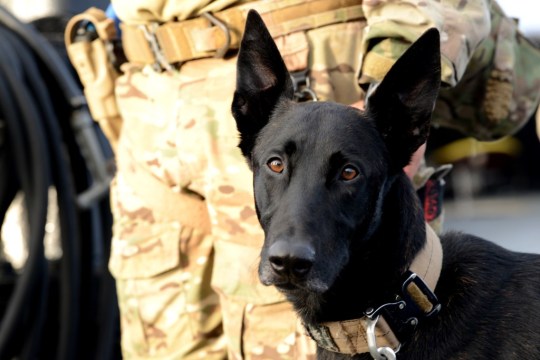
A Coast Guard Maritime Security Response Team West servicemember and his canine Wrangler search a target vessel during a joint training exercise, Nov. 5, 2019 (USCG)
In 2003, the Coast Guard initiated the modern Canine Program with 12 teams at Auburn University, in Alabama. In 2005, the program began training alongside its Department of Homeland Security partners at the Customs and Border Protection school in Front Royal, Virginia. In 2011, Coast Guard canine teams began receiving their initial training through the Transportation and Security Administration’s National Explosive Detection Canine Program, at Lackland Air Force Base in San Antonio.
For a canine team, the program begins with a 12-week course that instructs handlers on caring for and training their canine partners. Handlers and their dogs are trained to detect explosive odors on vessels, aircraft, railroad cars, automobiles, luggage, packages, and airline terminals. To graduate, the teams must achieve a 100 percent odor detection rating during a final evaluation in all search areas. After graduation, the teams return to their units where they develop specialized skills required by their respective ports. Handlers are also required to obtain qualifications in Emergency Vehicle Operations, Boarding Officer Certified Ashore, Canine Tactical Combat Casualty Care, and other certifications required by the Maritime Enforcement Specialist rating.
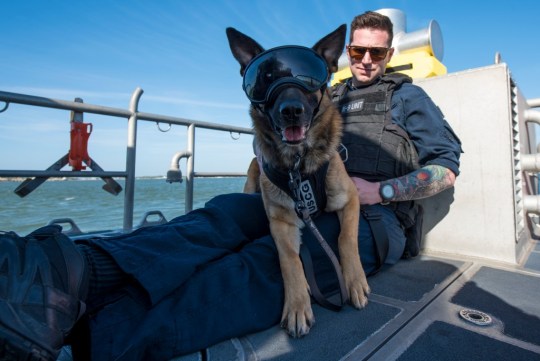
PO2 Michael Reklis and his canine partner Ali, from the Canine Explosive Detection Team at Maritime Safety and Security Team Kings Bay, rest before conducting hoist training Mar. 29, 2018 (USCG)
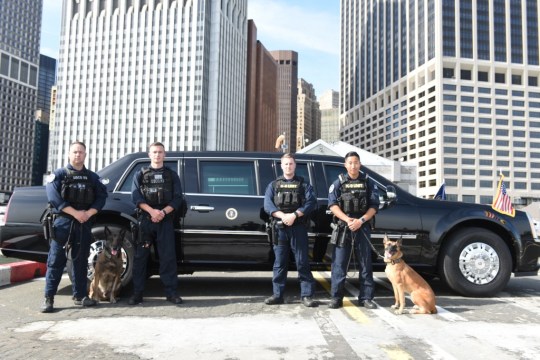
Coast Guard members of Maritime Safety and Security Team 91106 in New York, conduct explosives detection operations with canines Ruthie and Ryder during the United Nations General Assembly in New York City, September 21, 2016 (USCG)
Coast Guard canine teams maintain specialized skills to do their part in the Maritime Homeland Security mission set. In addition to deploying in austere environments far offshore, the canines must perform searches in tight spaces and, sometimes, loud engine rooms. In addition to these shipboard challenges, the canines must ascend and descend ladders to gain access to compartments deep inside vessels. Assuring that canines can search effectively in these environments takes months of training for the dogs and handlers.
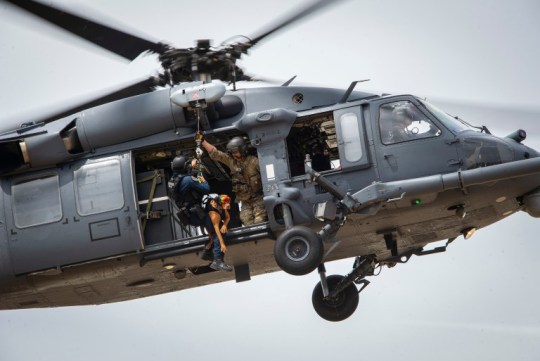
Feco, a Hungarian Vizsla single purpose bomb dog and his handler, PO1 Cory Sumner, U.S. Coast Guard District 11 Maritime Safety and Security Team, are hoisted onto a HH-60G Pave Hawk rescue helicopter, June 15, 2020 (USCG)
Vertical Delivery (VDEL) is the capability to deploy Canine Explosive Detection Teams (CEDTs) to vessels offshore via helicopter. This capability sets them apart from their Department of Homeland Security counterparts by enabling the Coast Guard teams to quickly and safely interdict vessels at sea. This capability also allows Coast Guard operational commanders to ensure the safety of U.S. ports by extending their reach hundreds of miles offshore from American ports.
VDEL from a helicopter requires complete trust between the handler and his canine partner. This trust is built over years. During these years, the canine learns that the handler will not endanger them unless absolutely necessary to preserve human life. Before a canine team can be deployed from a helicopter, the handler has to acclimate his canine partner to the sights, sounds and smells of a loud airborne asset. Additionally, after qualifying, the teams must train regularly for operational readiness and deployment at any time.
In addition to their helicopter delivery capability, the teams perform Vessel-to-Vessel Hoisting. Coast Guard canine handlers become subject matter experts in the practice of hoisting their canine partners from one vessel to another while underway. Again, the teams conduct rigorous training under dangerous conditions, including night-time and inclement weather deployments to ensure readiness for this vital mission.

Coast Guard maritime law enforcement specialists hoist Sirius, an explosive detection dog, alongside the moored Jeremiah O’Brien at Pier 45 in San Francisco, Friday, Aug. 19, 2011 (USCG)
CEDTs also support local, state and federal agencies during National Special Security Events, large public events, and as VIP protective services. Coast Guard CEDTs have ensured the security of thousands of people through explosives detection at such events as the Super Bowl, Rose Bowl Game and Parade, and Navy Fleet Week events. Working alongside their U.S. Secret Service partners, Coast Guard canine teams have also ensured the safety of diplomats, kings, first ladies and presidents, at such events as the State of the Union Address, United Nations General Assembly, and Democratic and Republican National Conventions.
One hallmark of the Coast Guard Canine Program is the policy allowing handlers to take their canine partners home with them. Other military services’ canine teams require their dogs to live in kennels for the duration of their service. The fact that Coast Guard canines live with their handlers greatly strengthens the trust vital to the success of the team when conducting high-risk missions.
Today’s Coast Guard has 18 globally deployable CEDTs. They are assigned to the service’s Maritime Safety and Security Teams (MSSTs) and Maritime Security and Response Teams (MSRTs) strategically positioned throughout the United States. These highly-trained canine teams are capable of deploying from helicopters and watercraft to meet a variety of onshore and offshore threats.
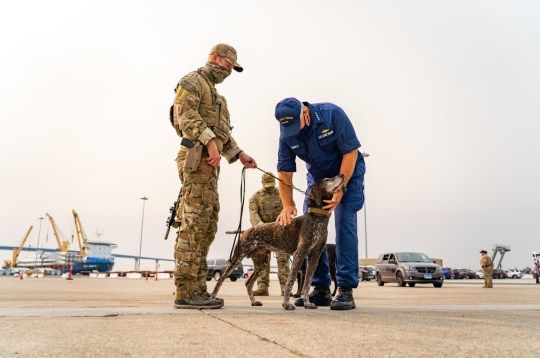
Adm. Karl Schultz, the commandant of the Coast Guard, pets Bingo, a German shorthaired pointer stationed at Maritime Security Response Team West, during a drug offload from Coast Guard Cutter Bertholf in San Diego, Sep. 10, 2020 (USCG)
Throughout its history, the Coast Guard Canine Program has adapted and evolved to the changing times much like the Coast Guard. The canines and handlers remain just as critical to our national security today as they did when the first dogs went into service in World War II.
This article appears courtesy of Coast Guard Compass and may be found in its original form here.
from Storage Containers https://www.maritime-executive.com/article/canines-in-the-service-of-maritime-security via http://www.rssmix.com/
0 notes
Text
2020 NBA play-offs: All you need to know about the first-round match-ups
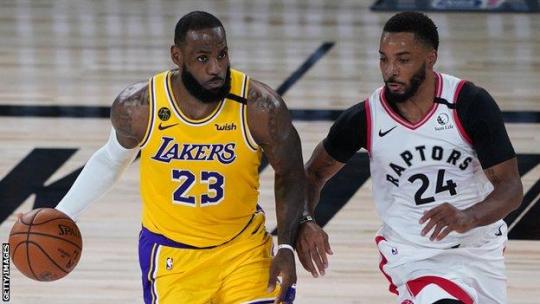
Will LeBron James add to his three NBA titles this season?
The 2020 NBA play-offs start on Monday in what is set to be one of the most unpredictable post-seasons in years, after a regular season like no other.
The play-offs usually begin in April but the coronavirus pandemic saw the season postponed on March 11.
It finally restarted without fans inside the NBA ‘bubble’ at Walt Disney World in Orlando at the end of last month, featuring 22 of the 30 franchises still in contention for a play-off place.
Those franchises have now been whittled down to 16. Here is what to look out for as they battle it out for a spot when the NBA Finals start on 30 September.
Lakers and Bucks ones to beat
Where else to start but LeBron James and the Los Angeles Lakers? The 35-year-old is in his 17th NBA season and is trying to win his fourth NBA title with his third franchise, having previously lifted it with the Miami Heat and Cleveland Cavaliers.
The Lakers clinched top seed in the Western Conference, despite winning just three out of eight games in the bubble, to reach the play-offs for the first time since 2013 and face the Portland Trail Blazers in the first round.
Victory for the Lakers would also be a fitting tribute to NBA and Lakers legend Kobe Bryant, who was killed in a helicopter crash in January.
While the Lakers’ attack is led by James and Anthony Davis, they will face a man in form in Damian Lillard.
Lillard top scored with 31 points as they beat the Memphis Grizzlies in the special play-in series to secure the final play-off berth on Saturday night. Afterwards he was named player of the bubble, having averaged 37.6 points as they won six of their eight games.
The 30-year-old has enjoyed a stellar year and his 61 points in Portland’s 134-131 win over Dallas Mavericks this month also saw him become only the second player in history to score 60-plus points in three matches in a single NBA season, after the legendary Wilt Chamberlain.
Western Conference Los Angeles Lakers (1) v Portland Trail Blazers (8) Los Angeles Clippers (2) v Dallas Mavericks (7) Denver Nuggets (3) v Utah Jazz (6) Houston Rockets (4) v Oklahoma City Thunder (5) Eastern Conference Milwaukee Bucks (1) v Orlando Magic (8) Toronto Raptors (2) v Brooklyn Nets (7) Boston Celtics (3) v Philadelphia 76ers (6) Indiana Pacers (4) v Miami Heat (5) Conference semi-finals start on 31 August, Conference finals on 15 September and NBA Finals on 30 September
The Toronto Raptors made history last year when they became the first non-American team to win the NBA title with a 4-2 series victory over Golden State Warriors.
Despite losing two-time NBA Finals MVP Kawhi Leonard to Los Angeles Clippers, the Raptors secured second place in the Eastern Conference this time round and a first-round meeting with the Brooklyn Nets.
Leonard meanwhile helped his new side the Clippers secure number two seed in the Western Conference for the first time in the franchise’s history. Like James, he is bidding to win an NBA title with his third franchise, having won with San Antonio Spurs in 2014 and the Raptors last year.
The Clippers take on Luka Doncic and the Dallas Mavericks in the first round. Slovenian Doncic became just the second European player to be named NBA Rookie of the Year last season following his move from EuroLeague side Real Madrid.
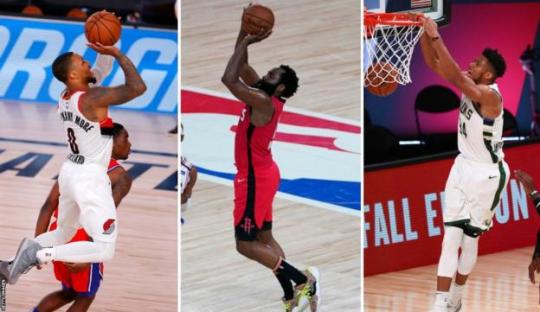
Portland Trail Blazers’ Damian Lillard, Houston Rockets guard James Harden and Giannis Antetokounmpo of the Milwaukee Bucks have starred for their teams this season
This year he is averaging a near triple-double of 28.8 points, 9.4 rebounds and 8.8 assists, which has seen him enter Most Valuable Player discussions at the age of just 21.
Reigning MVP Giannis Antetokounmpo helped Milwaukee Bucks become the team to secure a play-off spot earliest in NBA history in February.
They go into their first-round series against Orlando Magic with a 56-17 record – the best overall record in the league as they aim to secure their first title since 1971.
Battle of the MVPs
Greek Antetokounmpo is again among the contenders for 2020 MVP after another fine season.
James, who surpassed Bryant to become the NBA’s third-highest scorer of all time in January, is also nominated as he bids to become just the third player in NBA history to win the award five times, after Bill Russell and Michael Jordan.
James Harden of the Houston Rockets completes the nominees.
Harden, who won the award in 2018, has scored more points and made more three-pointers than anyone else in the NBA this season, averaging a league high 34.4 points-per-game.
He has been reunited with former Oklahoma City Thunder team-mate Russell Westbrook this season, and they face their former team in the play-offs.

Planning a barbecue soon?: Find out how to master it
Investigating fake news: Who spreads misinformation and why?

from WordPress https://ift.tt/2PZasII via IFTTT
0 notes
Photo
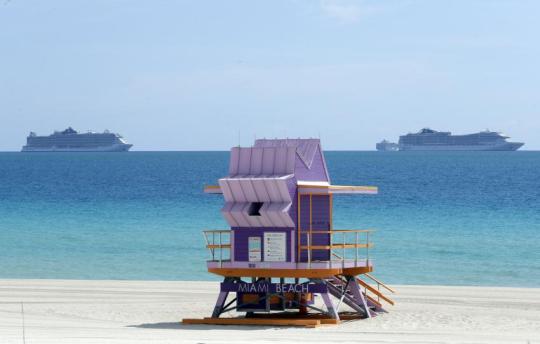
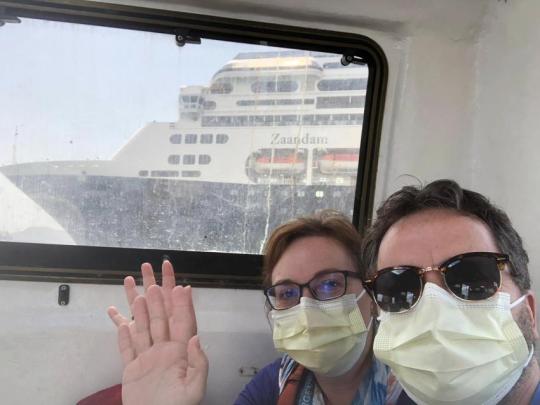
Ill-fated cruise ships given approval to dock in Florida FORT LAUDERDALE, Fla
A cruise ship that has been floating at sea with coronavirus patients aboard for two weeks after being turned away from South American ports was finally allowed to dock in Florida on Thursday.
The Zaandam and a sister ship sent to help it, the Rotterdam, were both given permission to disembark passengers at Port Everglades after days of negotiation with local officials who feared it would divert needed resources from a region that has seen a spike in virus cases.
The final agreement was reached on Thursday afternoon between local, state and federal officials and Carnival Corp., which owns the Zaandam and the Rotterdam, said Broward County officials and Holland America, the company that operates the ships.
Port Everglades traffic records listed the two ships’ arrival as “confirmed,” and helicopter images showed the Zaandam reached the port in Fort Lauderdale.
Holland America had said 45 passengers who were mildly sick would stay on board until they recovered, but that it needed 10 people to be taken to a Fort Lauderdale hospital for immediate medical care. Broward County Commissioner Michael Udine said the agreement only allowed for fewer than five people to be taken to a hospital.
For nearly three weeks, passengers have not been able to step on dry land. Four elderly passengers have died on the Zaandam, at least two from COVID-19, said William Burke, chief maritime officer for Carnival Corp., which owns the ships. Nine people have tested positive for the new coronavirus, Burke said earlier this week.
There are 442 guests and 603 crew on the Zaandam, and 808 guests and 583 crew on the Rotterdam. The Rotterdam was sent last week to take in some of the passengers and provide assistance to the Zaandam since it was denied permission to dock at ports in South America.
About 250 have reported influenza-like symptoms since March 22, including 17 aboard the Rotterdam, while 45 currently are mildly ill, Holland America Line has said.
In an email sent Wednesday night, Holland America said it had received approval from a hospital in Fort Lauderdale to treat fewer than 10 people “who need immediate critical care.” Jennifer Smith, a spokesman for Broward Health medical center, said it would accept the critically ill patients from the ship. It is not clear why the number of patients that would be treated had dropped under the agreement.
Originally firmly opposed to the ships' arrival, Florida Gov. Ron DeSantis told Fox News network earlier on Thursday that transferring critically ill patients to hospitals was "the humanitarian thing to do."
“There is no easy solution to this," DeSantis said.
DeSantis' comments came a day after President Donald Trump suggested that he had spoken to the governor and persuaded him to allow the ships to dock in Florida.
“We have to do something ... and the governor knows that, too,” Trump said Wednesday.
The passengers who are healthy need to get off the ships, and the rest need to be treated urgently, the nation's top infectious disease official, Dr Anthony Fauci said on Thursday. “You have to take care of the people who are ill. You just have an obligation to do that. And as quickly as possible," Fauci said on “CBS This Morning.”
Passengers and crew who have no symptoms of the virus will be bused to airports and will not be allowed inside the terminals, but will instead directly board airplanes, DeSantis said.
"You can't just release them into the general public if they have been exposed," he said.
Holland America has said that guests fit for travel under guidelines from the U.S. Centers for Disease Control would transfer “straight from the ship to flights for onward travel home, the majority on charter flights.”
“Out of an abundance of caution, these guests will be transported in coaches that will be sanitized, with limited person-to-person contact and while wearing masks," the company said in a statement.
Guests have not left the ship since March 14 and have self-isolated in their staterooms since March 22, the company said.
For most people, the virus causes symptoms including a fever, cough and body aches that clear up in two to three weeks without hospitalization But for some, especially older adults and people with existing health problems, it can cause more severe illness including pneumonia, in which case respirators may be necessary for survival.
Passenger Laura Gabaroni was transferred to the Rotterdam last Saturday, along with husband Juan Huergo and other passengers not showing signs of illness. Gabaroni said she would not be comfortable until she arrived on land.
“Many broken promises so far, so I'll believe it when I see it,” she told The Associated Press via a WhatsApp message.
Gabaroni and Huergo, both defense contractors in Orlando, set sail on a dream vacation aboard the Zaandam the day before the U.S. State Department advised people to avoid cruise travel and before any substantial restrictions were in place in Florida.
The Zaandam set sail from Buenos Aires on March 7 and was originally scheduled to end the first leg of the voyage at San Antonio, Chile, on March 21 before departing again for Fort Lauderdale. The cruise was stranded off the coast of Panama after it was not allowed to dock in Chile and other ports along its path.
0 notes
Text
Kobe Bryant’s ‘Mamba Army’ Fans Were as Relentless as He Was
The mention of Kobe Bryant could instantly start a fight, whether in a bar with friends or a in far-flung corner of the internet.
In the 2000s, fans angrily discussed whether Bryant, the Lakers superstar guard, was as good as the man he had modeled his game after, Michael Jordan, or even Tim Duncan, the San Antonio big man who would lead the Spurs to three of his five championships that decade.
LeBron James entered the conversation in the 2010s, and Bryant’s ardent defenders shrugged off the talented James as, indeed, no Kobe — look at the rings! By then Bryant had won five titles, including in 2010, and James had not won any. There was still much else to debate: Was Kobe a ball hog? Did he shoot too much? (No, of course not! You trust Smush Parker with those shots?)
The peak of such debates came in 2014, when a man in Southern California apparently drove almost an hour to try to fight a Celtics fan who had dared say on Twitter that Bryant wasn’t an elite player. Thus the phrase “Meet me in Temecula!” entered the cultural lexicon.
Fans of Bryant, who died in a helicopter crash on Sunday at the age of 41, were as relentless in his defense as he was on the basketball court. They felt like they had to be. Theirs was a different fandom than what had existed for past N.B.A. greats like Magic Johnson and Larry Bird. It was severe tribalism as a counter to an aversion to Bryant outside of Los Angeles, a reaction to those constantly underrating Bryant’s exceptional skill — at least in their eyes.
“To the degree that they are more aggressive and protective of his legacy or his game, I think that’s owed to reflecting his personality,” said Harrison Faigen, the editor of Silver Screen and Roll, a Lakers fan site under Vox Media’s SB Nation. “He was someone who really was out there in championing himself and talking about how great he was.”
For each time a sports fan declared that Bryant was an all-time good player instead of an all-time great, there was an equal and opposite reaction from Kobe’s fan base — known as the Mamba Army — feverishly pointing to his five championships.
“They’re fanatical in a way where they’re unwavering in their devotion to Kobe,” said Tyler, the popular Twitter personality @DragonflyJonez who has more than 172,000 followers and hosts the Jenkins & Jonez podcast. (He only goes by his first name in public.) “They don’t care what you say. They don’t care what the numbers say. It always comes down to five rings. At the end of the day, that’s what it always comes down to: Were you a winner or were you not?”
That was the era Bryant played in. He was one of the few superstars whose career spanned the explosion of both the internet and social media. N.B.A. Commissioner Adam Silver, during an interview on Monday, noted that Bryant had entered the league shortly after the league’s website launched. Facebook, Twitter and YouTube emerged in between his championship runs. When he retired in 2016, two decades after he was drafted, he did so with a poem that quickly went viral on social media.
All of this meant that as Bryant’s career progressed, published opinions weren’t limited to cranky newspaper columnists. Instead, fans got louder. And louder. Suddenly, there were N.B.A. message boards and Reddit posts where fans could have at it. Twitter amplified those discussions and democratized the assessment of player legacies. It wasn’t just up to shows like ESPN’s “Outside The Lines” and “Pardon The Interruption.”
“We had to spend so much time defending him,” said Anthony Irwin, who hosts a podcast called “Locked On Lakers.” (Until recently, Faigen was his co-host.)
“It became such a habit,” Irwin said. “You saw it even after his career. Any time some player did something incredible on the basketball court, there was always somebody out there who referenced it back to, ‘Wait, is Russell Westbrook better than Kobe now?’”
Bryant deftly used the digital age to enhance his own brand, targeting international audiences and rapidly expanding his fan base. Part of the reason Bryant devotees seemed to loom large in discussions is that there were so many of them all over the world, especially in China. But that relationship with his enthusiasts was compromised after he was charged with raping a 19-year-old woman in 2003. The case was dropped before it went to trial, and a separate lawsuit the woman filed was settled out of court. Even then, many of Bryant’s fans stuck by him.
“For better or for worse, you get an ‘us against the world’ mentality,” Irwin said. He added: “Over the course of Kobe’s career, especially the latter half, if you brought it up, it was, ‘Well, he didn’t actually get convicted of a crime.’ That was the starting point of that conversation. It got kind of gross.”
For his aficionados, Irwin said, what Bryant “did on the court now carried over to off the court. I’m not saying Lakers fans or Kobe fans handled that well, but where it came from was just, ‘He’s our guy.’”
News media mentions of the case since Bryant’s death have angered some of his supporters. The Washington Post reporter Felicia Sonmez tweeted a link to an article about the rape accusation in the hours after Bryant’s death and was immediately deluged with criticism and, she said, death threats. Sonmez said later that she had checked into a hotel out of fear for her safety. Other news media that mentioned the accusation in their coverage also have been met with backlash.
The intensity of the supporters is likely in part because Bryant hit his prime just when the N.B.A. was desperate for a new torch bearer. Jordan had retired for the third time in 2003. Fans wanted someone to step into an impossible-to-fill abyss. The problem for Bryant was that several players also vied for that role. Vince Carter, Tracy McGrady and Allen Iverson were all guards with flashes of Jordan’s flair. Even on the court, Bryant was a divisive figure. Some opposing fans thought his game lacked aesthetic beauty, even though his brutal competitiveness was universally acknowledged.
The gap between Bryant and those players at their best wasn’t as large as the canyon that existed between Jordan and the rest of the league in the 1990s. There is even an argument to be made that Bryant wasn’t the best player on his Lakers teams during his first three championships. This created more dispute among league observers as to whether Bryant was, as some said, truly the heir apparent to Jordan.
There were also simple, more traditional reasons for the loyalty of Bryant’s fans. He played for the same team his whole career, allowing him to spend 20 years cultivating a relationship with them. He won more than most other stars in that time frame. And playing for the Lakers, a historic franchise in a large Los Angeles media market, put him right in the middle of Hollywood, filled with celebrities he could hobnob with.
Bryant, like many of those celebrities, was also in living rooms every night as a constant presence on national television. A generation of West Coast dwellers grew up with him. As the rapper Snoop Dogg said on the Fox Sports show “Undisputed” on Wednesday: “When he first got to L.A., he wasn’t great. He was a kid. He was learning, and he was making mistakes. I was a kid at the same time. So it was a beautiful story watching his story and watching mine.”
Bryant certainly was not the first superstar to have a dedicated fan base. Bird probably doesn’t have to buy a meal in Boston ever again. Ditto for Iverson in Philadelphia. Jordan has his own committed legacy-protectors. But Bryant’s résumé in a rapidly expanding digital world created a new class of N.B.A. fan: millennials with multiple platforms on which to yell and defend their guy. Perhaps this is the point of fandom — to defend your rooting interest with gusto any way you can.
from WordPress https://mastcomm.com/kobe-bryants-mamba-army-fans-were-as-relentless-as-he-was/
0 notes
Text
#talkin#tik tok#op#huncho619#one piece#anime#took d. photo#king#franky#thousand sunny#sabo#revolutionary sabo#flame emperor sabo#sogeking#usopp#curly dadan#god usopp#buggy the clown#buggy d clown#buggy#shanks#red haired shanks#boa hancock#brook#soul king brook#chopper#tony tony chopper#anthony antonio helicopter#edward newgate#whitebeard
64 notes
·
View notes
Text
Helicopters, Cap Spikes and the Decision: The N.B.A.’s Wildest Off-Seasons
So many marquee names. So much money for teams to spend. This Sunday, starting at 6 p.m. Eastern Time, the N.B.A. could witness one of the wildest off-seasons in league history.
The Los Angeles Lakers and the Los Angeles Clippers are trying to lure Kawhi Leonard out of Canada after he just led the Toronto Raptors to the championship. Kevin Durant is considering the Knicks and the Nets, as well as the Clippers, along with a return to the Golden State Warriors.
Boston’s Kyrie Irving, Charlotte’s Kemba Walker, Philadelphia’s Jimmy Butler and Milwaukee’s Khris Middleton join Leonard — plus the injured but still deeply coveted duo of Durant and Klay Thompson from the Warriors — as the headliners in a deep free-agent class. It’s a lot to track — especially with nine teams expected to have at least $30 million in salary-cap space and roughly 200 other free agents in a league that offers only 450 full-time jobs.
The forecast for considerable movement is promising, given the go-for-it sentiment that has infected numerous front offices. The league’s sudden lack of a clear-cut favorite for the first time since Golden State’s championship run began in 2015 — provided Leonard decides not to return to Toronto — invites daring and deal-making.
Just don’t forget that the bar is rather high for any summer to go down as an all-timer, thanks to the N.B.A.’s reputation for transactional bedlam. To refresh you on how competitive this category can be, here are five standout off-seasons that set the standard for chaos:
1996: The Shaq-Daddy of Them All
For all the anticipation that the July marketplace generates in the modern N.B.A., we have yet to see an off-season that can match 1996 for leaguewide madness.
The Knicks signed Allan Houston and traded for Larry Johnson. Michael Jordan re-signed with the Chicago Bulls on a one-year, $30.4 million contract — lavish compensation at the time. The Miami Heat handed out the league’s first-ever contract exceeding $100 million, to Alonzo Mourning, then saw their seven-year, $98 million contract with Juwan Howard voided by the league for violating salary cap rules, sending Howard back to Washington. In mid-August, after things had died down, Phoenix dealt Charles Barkley to Houston.
But all of that was the (deep) undercard to Shaquille O’Neal’s first foray into free agency. Jerry West, then the Los Angeles Lakers’ general manager, persuaded the representatives for Kobe Bryant, 17, to insist that their client would play abroad if he wasn’t allowed to join the Lakers. Then West also traded Vlade Divac to the Charlotte Hornets in exchange for Bryant’s draft rights. That created nearly $5 million in extra salary-cap space.
On July 11, 1996, Charlotte and the Lakers finalized the Bryant trade. Seven days later, after West had created another $2 million-plus in cap space by trading Anthony Peeler and George Lynch to the Vancouver Grizzlies, O’Neal agreed to a seven-year, $120 million contract to leave Penny Hardaway and the Orlando Magic for the Lakers.
Shaq has maintained that an infamous Orlando Sentinel poll just two days before he committed to the Lakers sealed his decision to leave; 91.3 percent of more than 5,000 respondents had said he wasn’t worth a seven-year, $115 million deal. The Magic had gone 60-22 in the 1995-96 season, O’Neal’s last in Orlando. They have not won 60 games in a season since.
2003: The Helicopters
When the Golden State Warriors followed a 73-win season in 2016 by signing Kevin Durant, there was an outcry that the Warriors were ruining basketball by hoarding superstars.
Often forgotten is that a similar scenario nearly played out with the San Antonio Spurs in the summer of 2003 — except the howling was muted in an era that predated social media and the proliferation of sports TV debate shows.
The Spurs’ response to beating the Nets in the 2003 finals was to stage one of the most ornate free-agent recruiting efforts ever to try to sign the Nets’ franchise star, Jason Kidd. The Spurs put up Kidd at a fancy golf resort in San Antonio in a nod to his other favorite sport, leading to multiple sightings of news helicopters overhead.
The Nets, though, won Kidd over after he returned to New Jersey. Duncan, the All-Star big man, and Spurs Coach Gregg Popovich made a trip East to continue lobbying Kidd, but the future Hall of Fame point guard ultimately decided to stay with the team he had just led to back-to-back finals appearances.
2010: The Decision
It was a line that not only defined an off-season but that will likely follow LeBron James well beyond retirement: “I’m going to take my talents to South Beach.”
He said it as part of a widely panned television event conceived to give the best basketball player of his generation, and a native son of Akron, Ohio, an unparalleled platform to announce that he was leaving the Cleveland Cavaliers to join the Miami Heat. That James took advantage of the enormous interest in his decision to raise money for the Boys & Girls Club was largely lost as people wrote him off as egotistic and debated whether his plan, to join forces with Dwyane Wade and, later, Chris Bosh on a South Beach superteam, was an insult to the stars of the past who tried to beat their friends rather than join them.
It didn’t calm things down any that the league’s new-age Big Three, seemingly assembled by the players themselves as much as by Pat Riley, Miami’s team president, subsequently held a welcoming parade at American Airlines Arena. They came out in their uniforms, Bosh flexed and yelled, and James promised “not two, not three, not four, not five, not six, not seven …” championships.
Significant money was doled out to Amar’e Stoudemire, Joe Johnson and David Lee, but none of the other deals that summer could compare to Miami’s machinations.
The league’s Player Power era, with James as the foremost star, was officially underway. N.B.A. off-seasons would never be the same — as James showed us again in 2014 when he left South Beach to go back home to the Cavaliers.
2016: The Cap Spike
Had the Warriors won the 2016 finals, chances are Durant never joins them. But, as any N.B.A. fan knows, they blew a 3-1 lead and lost to LeBron’s Cavaliers. Even so, Golden State also needed the good fortune of a mammoth cap spike. A huge increase in the league’s new television contract and the players’ union’s refusal to let the league infuse the money gradually hiked the salary cap by a whopping $24.1 million. That enabled the Warriors to sign a superstar they wouldn’t have been able to afford otherwise — and it also led to a leaguewide spending spree that is rarely remembered fondly.
The Lakers committed $137 million to Luol Deng and Timofey Mozgov. The Knicks gave $122 million to Joakim Noah and Courtney Lee. Several more questionable deals were signed, which made the major paydays to franchise stalwarts such as Mike Conley (five years, $153 million from Memphis), DeMar DeRozan (five years, $139 million from Toronto) and Bradley Beal (five years, $128 million from Washington) seem reasonable by comparison.
The Cousins signing, to many, presumably made the 2018-19 season a foregone conclusion.
But a different deal decided the season. Masai Ujiri, president of the Toronto Raptors, shocked the N.B.A. by trading away his franchise star, DeMar DeRozan, in a mid-July swap that netted Kawhi Leonard and Danny Green. It seemed to be an enormous risk, with the Raptors coming off a 59-win season. Also both players Ujiri acquired were, effectively, rentals. On top of that, Leonard’s health was in doubt after he sat out nearly all of the 2017-18 season in San Antonio.
But Ujiri’s off-season dice rolls, which also included his decision to replace Coach Dwane Casey, led to Toronto’s first title. James, for the first since 2005, missed the playoffs entirely.
Sahred From Source link Sports
from WordPress http://bit.ly/2Xc46qy via IFTTT
0 notes
Text
As I Scrolled Through These Photos, My Heart Sunk More And More. But I'm Glad I Saw It.
New Post has been published on https://kidsviral.info/as-i-scrolled-through-these-photos-my-heart-sunk-more-and-more-but-im-glad-i-saw-it/
As I Scrolled Through These Photos, My Heart Sunk More And More. But I'm Glad I Saw It.
Each year, the World Press Association gathers to select a photo of the year. Countless photographers send in their work to compete for the award. Their work can range from sad to terrifying to joyful and to loving… a true embodiment of the human spirit. This list is comprised of every winner since the year 1955 and you won’t believe half of the things you are seeing. Who knew things like this were going on in the world every day…
1955: A competitor tumbles off his motorcycle during the Motorcross World Championship at the Volk Mølle race course. (By Mogens von Haven)
1956: A German World War II prisoner, released by the Soviet Union, is reunited with his daughter. The child had not seen her father since she was one-year-old. (By Helmuth Pirath)
1957: Dorothy Counts, one of the first black students to enter the newly desegregated Harry Harding High School is mocked by whites on her first day of school. (By Douglas Martin)
1958: National Football Championships between Prague and Bratislava. (By Stanislav Tereba)
1960: A right-wing student in Japan assassinates Inejiro Asanuma, Socialist Party Chairman, during his speech at the Hibiya Hall. (By Yasushi Nagao)
1962: Priest Luis Padillo offers last rites to a loyalist soldier who is mortally wounded by a sniper during military rebellion against President Bétancourt at Puerto Cabello naval base in Venezuela. (By Héctor Rondón Lovera)
1963: Buddhist monk Thich Quang Duc sets himself ablaze in protest against the persecution of Buddhists by the South Vietnamese government. (By Malcolm W. Browne)
1964: A Turkish woman mourns her dead husband, a victim of the Greek-Turkish civil war. (By Don McCullin)
1965: A mother and her children wade across a river to escape US bombing. The US Air Force had evacuated their village because it was suspected of being used as a base camp by the Vietcong. (By Kyoichi Sawada)
1966: The body of a Vietcong soldier is dragged behind an American armored vehicle en route to a burial site after fierce fighting. (By Kyoichi Sawada)
1967: The commander of an M48 tankgunner of the US 7th regiment in Vietnam’s ‘Iron Triangle’. (By Co Rentmeester)
1968: South Vietnam national police chief Nguyen Ngoc Loan executes a suspected Viet Cong member. (By Eddie Adams)
1969: A young Catholic wears a gasmask during clashes with British troops. People had been fleeing from teargas after a night of street fighting. (By Hanns-Jörg Anders)
1971: During negotiations on the safe-conduct of a group of criminals on the run, police superintendent Gross suddenly shoots down gang leader Kurt Vicenik. The gang, who had disappeared after a bank-robbery in Cologne, re-emerged near Saarbrücken, carrying a hostage with them. A chase followed and the police and the robbers met at Baltersweiler. The two other men were captured in a wild fight. The men running away from the bullets are policemen. (By Wolfgang Peter Geller)
1972: Phan Thi Kim Phuc (center) flees with other children after South Vietnamese planes mistakenly dropped napalm on South Vietnamese troops and civilians. (By Nick Ut)
1973: Democratically elected President Salvador Allende moments away from death during military coup at Moneda presidential palace in Chile. (By Orlando Lagos)
1974: The Faces of Hunger. A mother comforts her child, both victims of drought. (By Ovie Carter)
1975: A mother and her daughter are hurled off a collapsing fire-escape in an apartment house fire in Boston. (By Stanley Forman)
1976: Palestinian refugees in district La Quarantaine. (By Françoise Demulder)
1977: Police throw tear-gas at a group of chanting residents of the Modderdam squatter camp protesting against the demolition of their homes outside Cape Town. (By Leslie Hammond)
1978: A demonstrator is engulfed in flames of the molotov cocktail he was about to throw at the police during protests against the construction of the New Tokyo International Airport. The original Narita Airport plan was unveiled in 1966. To acquire the initial land, the government had to evict protesting landowners. Violent clashes between the opponents and authorities resulted in 13 deaths, including five police officers. The new airport opened in May 1978. (By Sadayuki Mikami)
1979: A Cambodian woman cradles her child while waiting for food to be distributed at a refugee camp. (By David Burnett)
1980: A starving boy and a missionary in Uganda. (By Mike Wells)
1981: Lt. Col. Antonio Tejero Molina orders everyone to remain seated and be quiet after armed Guardia Civil soldiers stormed the Assembly Hall of the Spanish Parliament. Three hundred deputies and cabinet members were in session to vote upon the succession of premier Suarez. They were released next morning after having been held hostage for almost 18 hours; the coup was a failure. (By Manuel Pérez Barriopedro)
1982: The war in Lebanon: The aftermath of the massacre of Palestinians by Christian Phalangists in the Sabra and Shatila refugee camps. (By Robin Moyer)
1983: Kezban Özer (37) finds her five children buried alive after a devastating earthquake. At five o’clock in the morning she and her husband were milking the cows as their children slept. A few minutes later, 147 villages in the region were destroyed by an earthquake of magnitude 7.1 on the Richter scale; 1,336 people died. (By Mustafa Bozdemir)
1984: A child killed by the poisonous gas leak in the Union Carbide chemical plant disaster. (By Pablo Bartholomew)
1985: Omaira Sanchez (12) is trapped in the debris caused by the eruption of Nevado del Ruíz volcano. After sixty hours she eventually lost consciousness and died of a heart attack. (By Frank Fournier)
1986: Ken Meeks’ (42) skin is marked with lesions caused by Aids-related Kaposi’s Sarcoma. (By Alon Reininger)
1987: A mother clings to a riot policeman’s shield at a polling station. Her son was one of thousands of demonstrators arrested because they tried to prove that the presidential election on December 15, which was won by the government candidate, had been rigged. (By Anthony Suau)
1988: Boris Abgarzian grieves for his 17-year-old son, victim of the Armenian earthquake. (By David Turnley)
1989: A demonstrator confronts a line of People’s Liberation Army tanks during protests for democratic reform. (By Charlie Cole)
1990: Family and neighbors mourn the death of Elshani Nashim (27), killed during a protest against the Yugoslavian government’s decision to abolish the autonomy of Kosovo. (By Georges Merillon)
1991: US Sergeant Ken Kozakiewicz (23), gives vent to his grief as he learns that the body bag at his feet contains the remains of his friend Andy Alaniz. ‘Friendly fire’ claimed Alaniz’s life and injured Kozakiewicz. On the last day of the Gulf War they were taken away from the war zone by a MASH unit evacuation helicopter. (By David Turnley)
1992: A mother carries her dead child to the grave, after wrapping it in a shroud according to local custom. A bad drought coupled with the effects of civil war caused a terrible famine in Somalia which claimed the lives of between one and two million people over a period of two years, more than 200 a day in the worst affected areas. The international airlift of relief supplies which started in July was hampered by heavily armed gangs of clansmen who looted food storage centers and slowed down the distribution of the supplies by aid organizations. (By James Nachtwey)
1993: Boys raise toy guns in a gesture of defiance. The Palestinian uprising, which began in December 1987, strengthened the Arab population in their determination to fight the occupying force. In March Israel closed its border with Gaza, causing a massive rise in unemployment. With more than 800,000 people contained in the Israeli-patrolled, eight-km-wide strip of land, bloodshed increased sharply. The peace agreement signed in Washington on September 13 promised limited authority for the Gaza Strip and a withdrawal of the Israeli army. (By Larry Towell)
1994: A Hutu man at a Red Cross hospital, his face mutilated by the Hutu ‘Interahamwe’ militia, who suspected him of sympathizing with the Tutsi rebels. (By James Nachtwey)
1995: A bus on the road leading to Grozny during fighting between Chechen independence fighters and Russian troops. The civil war which erupted when President Yeltsin sent troops to the rebellious province in December 1994 was still dragging on months later. When the Chechen fighters fled Grozny, the capital, where the war had claimed a horrendous human and material toll, Russian troops pursued them into the countryside to the south and east. (By Lucian Perkins)
1996: Landmine victims in Kuito, a town where many people were killed and traumatized during the civil war. (By Francesco Zizola)
1997: A woman cries outside the Zmirli Hospital, where the dead and wounded were taken after a massacre in Bentalha. (By Hocine)
1998: A woman is comforted by relatives and friends at the funeral of her husband. The man was a soldier with the ethnic Albanian rebels of the Kosovo Liberation Army, fighting for independence from Serbia. He had been shot the previous day while on patrol. (By Dayna Smith)
1999: A man walks the streets in one of the largest gathering points for ethnic Albanian refugees fleeing violence in Kosovo. (By Claus Bjørn Larsen)
2000: The mother of a Mexican immigrant family makes piñatas to support herself and her children. The family numbers among the millions of ‘uncounted’ Americans, people who for one reason or another have been missed by the national census and so don’t exist in population records. (By Lara Jo Regan)
2001: The body of a one-year-old boy who died of dehydration is prepared for burial at Jalozai refugee camp. The child’s family, originally from North Afghanistan, had sought refuge in Pakistan from political instability and the consequences of drought. The family gave the photographer permission to attend as they washed and wrapped his body in a white funeral shroud, according to Muslim tradition. In the overcrowded Jalozai camp, 80,000 refugees from Afghanistan endured squalid conditions. (By Erik Refner)
2002: A boy holds his dead father’s trousers as he squats beside the spot where his father is to be buried, surrounded by soldiers and villagers digging graves for victims of an earthquake in Armenia. (By Eric Grigorian)
2003: An Iraqi man comforts his four-year-old son at a holding center for prisoners of war, in the base camp of the US Army 101st Airborne Division near An Najaf. The boy had become terrified when, according to orders, his father was hooded and handcuffed. A soldier later severed the plastic handcuffs so that the man could comfort his child. Hoods were placed over detainees’ heads because they were quicker to apply than blindfolds. The military said the bags were used to disorient prisoners and protect their identities. It is not known what happened to the man or the boy. (By Jean-Marc Bouju)
2004: A woman mourns a relative killed in the tsunami. On December 26, a 9.3 magnitude earthquake off the coast of Sumatra, Indonesia, triggered a series of deadly waves that traveled across the Indian Ocean, wreaking havoc in nine Asian countries, and causing fatalities as far away as Somalia and Tanzania. (By Arko Datta)
2005: The fingers of malnourished Alassa Galisou (1) are pressed against the lips of his mother Fatou Ousseini at an emergency feeding center. One of the worst droughts in recent times, together with a particularly heavy plague of locusts that had destroyed the previous year’s harvest, left millions of people severely short of food. (By Finbarr O’Reilly)
2006: Young Lebanese drive down a street in Haret Hreik, a bombed neighborhood in southern Beirut. (By Spencer Platt)
2007: A soldier of Second Platoon, Battle Company of the Second Battalion of the US 503rd Infantry Regiment sinks onto an embankment in the Restrepo bunker at the end of the day. (By Tim Hetherington)
2008: Detective Robert Kole of the Cuyahoga County Sheriff’s Office enters a home, following mortgage foreclosure and eviction. He needs to check that the owners have vacated the premises, and that no weapons have been left lying around. (By Anthony Suau)
2009: Women shout their dissent from a Tehran rooftop on 24 June, following Iran’s disputed presidential election. (By Pietro Masturzo)
2010: Bibi Aisha, an 18-year-old woman from Oruzgan province in Afghanistan, fled back to her family home from her husband’s house, complaining of violent treatment. The Taliban arrived one night, demanding Bibi be handed over to face justice. After a Taliban commander pronounced his verdict, Bibi’s brother-in-law held her down and her husband sliced off her ears and then cut off her nose. Bibi was abandoned, but later rescued by aid workers and the U.S. military. (By Jodi Bieber)
2011: A veiled woman holds a wounded relative “inside a mosque used as a field hospital by demonstrators against the rule of President Ali Abdullah Saleh, during clashes in Sanaa, Yemen. (By Samuel Aranda)
2012: A group of men carry the bodies of two dead children through a street in Gaza City. (By Paul Hansen)
To see more amazing photography, visit the World Press Association website.
Source
Read more: http://viralnova.com/world-press-photos/
0 notes
Text
Canines in the Service of Maritime Security
[By MLE2 Anthony M. Ross, USCG]
The United States Coast Guard has a long history of military working animals. During the early years of World War II, German spies landed on East Coast beaches and enemy subs were sighted on East and West coasts. These incidents led to the establishment of Coast Guard beach patrols and, by August 1942, the first Coast Guard dog was on patrol. During the war, 2,000 dogs participated in beach patrols alongside their Coast Guard handlers.

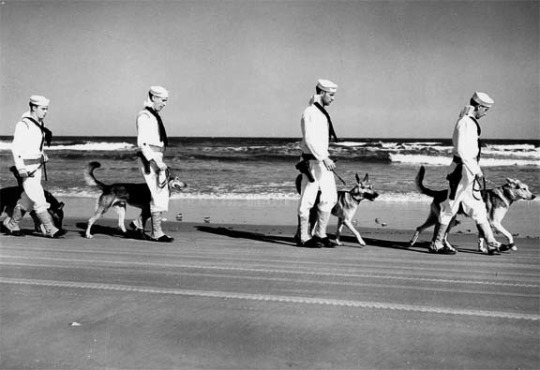
Coast Guard canines conduct beach patrols during World War II
In the 1990s, there were several Coast Guard canine teams in service. These teams were located at Station Sandy Hook, New Jersey, and Station South Padre Island, Texas, and used mainly for narcotics detection. In addition, there was a narcotic detection canine stationed at the Law Enforcement Detachment (LEDET) in Miami, Florida. Over the years, the Coast Guard’s narcotics detection canine program has remained relatively small. Normally, Coast Guard units find narcotics on the order of hundreds of pounds. With drug quantities of this scale, there’s no need for a dog, because humans can visually locate the drugs.
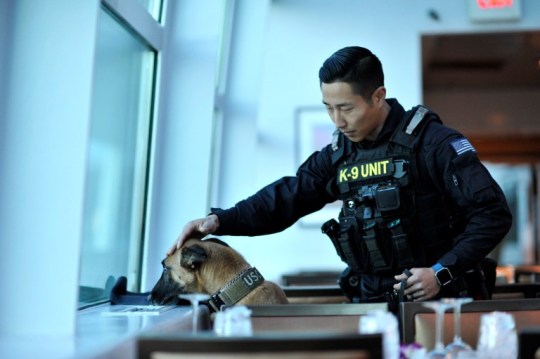
PO2 Richard Bacone from Maritime Safety and Security Team New York conducts a security sweep with his canine, Ruthie, during a dinner cruise in Washington, D.C., Jan. 19, 2017 (USCG)
As new mission threats have evolved, the Coast Guard’s canine team capability has also evolved. The modern Coast Guard Canine Explosive Detection Program was initiated as a result of the September 11th terrorist attacks. The Coast Guard was tasked with a variety of Maritime Homeland Security missions, which included high-capacity vessel safety and security for cruise ships and ferries and the best tool for this job is an explosive detection canine team. Due to the canine’s unique ability to detect even the smallest amount of explosives, Coast Guard units could effectively screen vessels before and after they left port. Thus, the modern Coast Guard Canine Program was born.
The service’s preference of dog breed for law enforcement and substance detection mission has changed through the years. During World War II, the Coast Guard used mostly Doberman Pinschers; however, like other military branches, the Coast Guard often received dogs from civilians who gave up pets for the war effort. Therefore, the service used a variety of breeds for its beach patrol in the early days of the program. The breeds first used in the modern Coast Guard Canine Program were Labrador Retrievers; however, as the science of canine capabilities has progressed, the service has added specific breeds, such as German Shepherds, Belgian Malinois, German Short Haired Pointers and Vizslas.
Coast Guard canine handlers are also a special breed. Candidates must be Maritime Enforcement Specialists of the highest caliber with an enlisted rank of at least a second-class petty officer. Members that apply must receive a positive endorsement from their commanding officer and a thorough screening by headquarters. Selectees must also dedicate six years to the service to ensure they are committed to the demands of this highly sought after position.
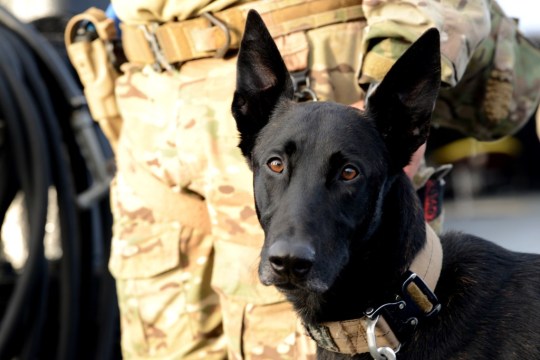
A Coast Guard Maritime Security Response Team West servicemember and his canine Wrangler search a target vessel during a joint training exercise, Nov. 5, 2019 (USCG)
In 2003, the Coast Guard initiated the modern Canine Program with 12 teams at Auburn University, in Alabama. In 2005, the program began training alongside its Department of Homeland Security partners at the Customs and Border Protection school in Front Royal, Virginia. In 2011, Coast Guard canine teams began receiving their initial training through the Transportation and Security Administration’s National Explosive Detection Canine Program, at Lackland Air Force Base in San Antonio.
For a canine team, the program begins with a 12-week course that instructs handlers on caring for and training their canine partners. Handlers and their dogs are trained to detect explosive odors on vessels, aircraft, railroad cars, automobiles, luggage, packages, and airline terminals. To graduate, the teams must achieve a 100 percent odor detection rating during a final evaluation in all search areas. After graduation, the teams return to their units where they develop specialized skills required by their respective ports. Handlers are also required to obtain qualifications in Emergency Vehicle Operations, Boarding Officer Certified Ashore, Canine Tactical Combat Casualty Care, and other certifications required by the Maritime Enforcement Specialist rating.
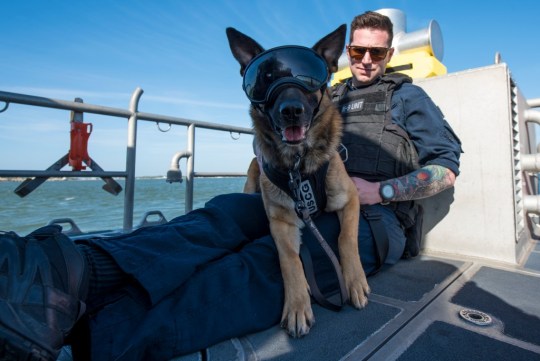
PO2 Michael Reklis and his canine partner Ali, from the Canine Explosive Detection Team at Maritime Safety and Security Team Kings Bay, rest before conducting hoist training Mar. 29, 2018 (USCG)
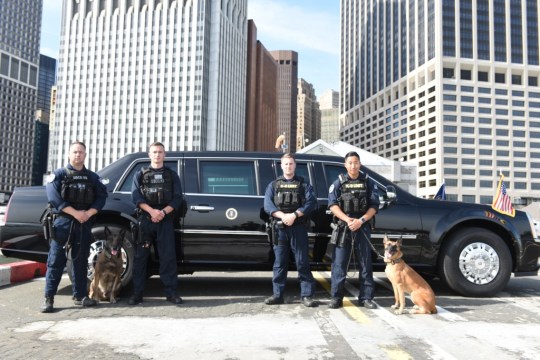
Coast Guard members of Maritime Safety and Security Team 91106 in New York, conduct explosives detection operations with canines Ruthie and Ryder during the United Nations General Assembly in New York City, September 21, 2016 (USCG)
Coast Guard canine teams maintain specialized skills to do their part in the Maritime Homeland Security mission set. In addition to deploying in austere environments far offshore, the canines must perform searches in tight spaces and, sometimes, loud engine rooms. In addition to these shipboard challenges, the canines must ascend and descend ladders to gain access to compartments deep inside vessels. Assuring that canines can search effectively in these environments takes months of training for the dogs and handlers.
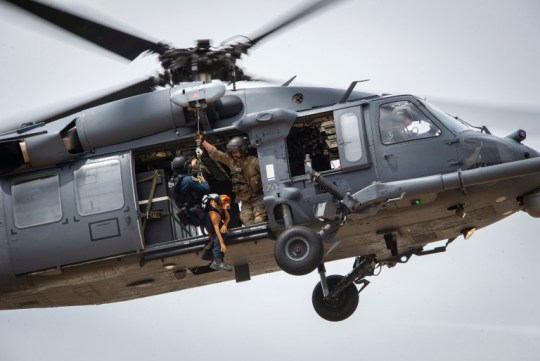
Feco, a Hungarian Vizsla single purpose bomb dog and his handler, PO1 Cory Sumner, U.S. Coast Guard District 11 Maritime Safety and Security Team, are hoisted onto a HH-60G Pave Hawk rescue helicopter, June 15, 2020 (USCG)
Vertical Delivery (VDEL) is the capability to deploy Canine Explosive Detection Teams (CEDTs) to vessels offshore via helicopter. This capability sets them apart from their Department of Homeland Security counterparts by enabling the Coast Guard teams to quickly and safely interdict vessels at sea. This capability also allows Coast Guard operational commanders to ensure the safety of U.S. ports by extending their reach hundreds of miles offshore from American ports.
VDEL from a helicopter requires complete trust between the handler and his canine partner. This trust is built over years. During these years, the canine learns that the handler will not endanger them unless absolutely necessary to preserve human life. Before a canine team can be deployed from a helicopter, the handler has to acclimate his canine partner to the sights, sounds and smells of a loud airborne asset. Additionally, after qualifying, the teams must train regularly for operational readiness and deployment at any time.
In addition to their helicopter delivery capability, the teams perform Vessel-to-Vessel Hoisting. Coast Guard canine handlers become subject matter experts in the practice of hoisting their canine partners from one vessel to another while underway. Again, the teams conduct rigorous training under dangerous conditions, including night-time and inclement weather deployments to ensure readiness for this vital mission.
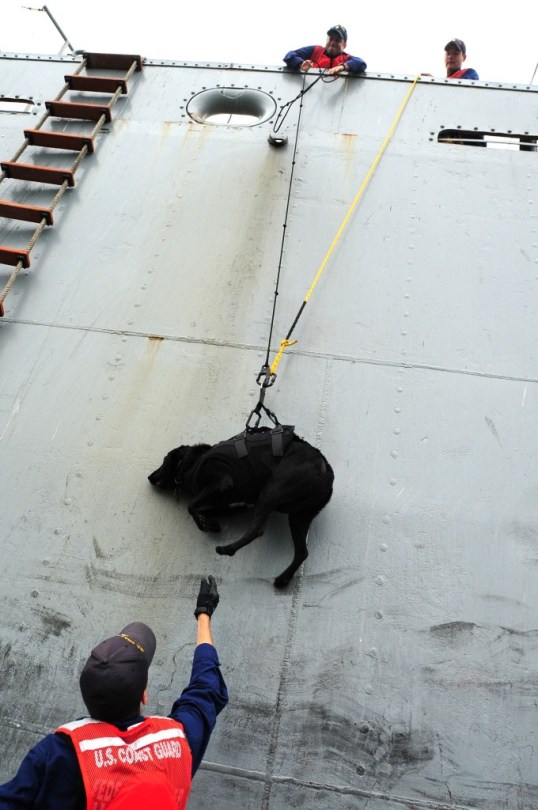
Coast Guard maritime law enforcement specialists hoist Sirius, an explosive detection dog, alongside the moored Jeremiah O’Brien at Pier 45 in San Francisco, Friday, Aug. 19, 2011 (USCG)
CEDTs also support local, state and federal agencies during National Special Security Events, large public events, and as VIP protective services. Coast Guard CEDTs have ensured the security of thousands of people through explosives detection at such events as the Super Bowl, Rose Bowl Game and Parade, and Navy Fleet Week events. Working alongside their U.S. Secret Service partners, Coast Guard canine teams have also ensured the safety of diplomats, kings, first ladies and presidents, at such events as the State of the Union Address, United Nations General Assembly, and Democratic and Republican National Conventions.
One hallmark of the Coast Guard Canine Program is the policy allowing handlers to take their canine partners home with them. Other military services’ canine teams require their dogs to live in kennels for the duration of their service. The fact that Coast Guard canines live with their handlers greatly strengthens the trust vital to the success of the team when conducting high-risk missions.
Today’s Coast Guard has 18 globally deployable CEDTs. They are assigned to the service’s Maritime Safety and Security Teams (MSSTs) and Maritime Security and Response Teams (MSRTs) strategically positioned throughout the United States. These highly-trained canine teams are capable of deploying from helicopters and watercraft to meet a variety of onshore and offshore threats.
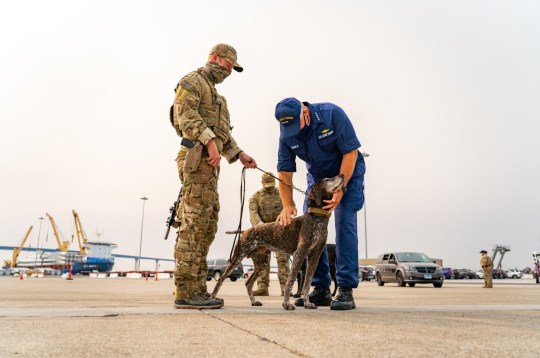
Adm. Karl Schultz, the commandant of the Coast Guard, pets Bingo, a German shorthaired pointer stationed at Maritime Security Response Team West, during a drug offload from Coast Guard Cutter Bertholf in San Diego, Sep. 10, 2020 (USCG)
Throughout its history, the Coast Guard Canine Program has adapted and evolved to the changing times much like the Coast Guard. The canines and handlers remain just as critical to our national security today as they did when the first dogs went into service in World War II.
This article appears courtesy of Coast Guard Compass and may be found in its original form here.
from Storage Containers https://maritime-executive.com/article/canines-in-the-service-of-maritime-security via http://www.rssmix.com/
0 notes
Text
NBA Rumors: Unpacking Kawhi, Kevin Love, Lillard and More
Every now and then the NBA produces a news cycle that reminds the whole world that basketball is the best, weirdest and most entertaining sport on the planet. The past 24 hours have done just that. It began with whispers of Kawhi discord coming from San Antonio, it kicked into high gear with the Bucks’ toppling of the Jason Kidd statue in Milwaukee, and then we were off. Then: Kevin Durant was taking shots at Clint Capela, Kevin Love was defending himself in team meetings, John Wall was losing to the Mavericks and getting roasted by J.J. Barea, DeAndre Jordan wasn’t on the Clippers bench, Michael Jordan was refuting trade rumors, Damian Lillard was having fireside chats with a billionaire, and … it was a great run.
For posterity’s sake, and for the sake of any well-adjusted adults out there who don’t live their lives checking Twitter every 90 seconds, let’s run through the biggest highlights.
Kawhi Leonard is becoming distant
So here’s where the day began. Around noon Monday, Adrian Wojnarowski, Michael C. Wright, and Zach Lowe contributed to the following report:
Months of discord centering on elements of treatment, rehabilitation and timetables for return from a right quadriceps injury have had a chilling impact on San Antonio Spurs star Kawhi Leonard’s relationship with the franchise and coaching staff, league sources told ESPN.
Under president and coach Gregg Popovich and general manager RC Buford, the Spurs have a two decades-long history of strong relationships with star players, but multiple sources describe Leonard and his camp as “distant” and “disconnected” from the organization.
That report included a fairly strong denial from Spurs GM RC Buford—”There is no issue between the Spurs organization and Kawhi”—so take that for what you will. San Antonio has been the most successful organization in the league over the past 20 years, but we’re coming off 18 months of rumors that Lamarcus Aldridge was unhappy, all of which were denied vehemently by the Spurs themselves. Then a few weeks ago, Gregg Popovich emerged to more or less confirm every rumor we’d heard about the LaMarcus relationship the past two years.
Now: Does this mean Kawhi is going to request a trade and/or join Twitter to start tweeting cryptic things about his future? Probably not. It’s possible, even likely, that this is a case of everyone being frustrated while the injury resolves itself, and everything will be fine once Kawhi is playing again. But it’s worth monitoring. Leonard is one of the five or six best players in the league. While the entire sport obsesses over the futures of Giannis Antetokounmpo and Anthony Davis, both of whom are under contract for several more years, Kawhi is more accomplished than either one and is a free agent at the end of next season. And he might be frustrated in San Antonio?
The Kawhi injury situation was already one of the strangest stories of the season—no one in the NBA knows what’s happening, why he’s missed this much time, or when he might get back to 100%—and thanks to ESPN’s report it just became even more strange.
Jason Kidd is done in Milwaukee
The Bucks have lost six of eight games, they got drilled by the 76ers over the weekend, and that was the end of the line for Jason Kidd in Milwaukee. He will be remembered for baffling lineup decisions and end-of-game strategies that defied basic math:
I wrote about Kidd’s role earlier in the season. Aside from the funny end-of-game decisions that drove Twitter crazy, this was the right move because Kidd’s limits made the future murkier for the entire team.
A coach who ignores lineup data and basic math is generally betraying a broader lack of intellectual curiosity, and that was certainly true with Kidd, who remained inflexible in his philosophy on both ends of the floor. And a bad coach makes everything more complicated. By failing to optimize the talent on hand, he makes it tougher for the front office to gauge what their roster really has, and what they need. That was the Bucks for the past few years—now they have another few months to make a run with interim coach Joe Prunty, and they’ll begin a search for a new coach this summer. With Giannis under contract until 2021, they’ll have no shortage of suitors.
Speaking of Giannis, in the immediate aftermath of the firing we were hit with reports that the Bucks superstar was crestfallen when he heard the news.
Jason Kidd may have been ham–fisted as a head coach, but he is Sun Tzu when it comes to managing the media.
Kevin Durant accidentally dunks on himself
It’s unfair to pretend that KD has an easy job in Golden State. He’s great on defense for the Warriors, and he’s a killer on offense, and he’s one of the 30 greatest players of all time. So, no shots at KD, at least from me. But it’s pretty funny to imagine how many team groupchats around the NBA must have included this tweet yesterday. There had to have been at least 10 rosters roasting him at once. Granted, all of those teams will eventually be vaporized by the Warriors on the court, but that was a given all along. On Monday afternoon, Spiderman memes won the day.
Speaking of losing to the Warriors …
The Cavs had a team meeting
LeBron James is settling in nicely to the “Puff Daddy in Making the Band“ phase of his career on the Cavs, and it sounds like he decided to shut down the studio with the Cavs this weekend. Kevin Love was the target of his ire this time, because apparently the solution to not giving up 148 points to the Thunder (!!) would’ve been adding Love’s defense to the mix. I don’t know. It’s very possible that LeBron is leaving this summer, but for now he wants a sugar cookie, so somebody better make it happen.
John Wall gets roasted by JJ Barea
Wall, who is coming off a dysfunctional team meeting of his own, has been in the midst of a season-long tribute to the late-90s and early-2000s NBA, a version of the league in which players were less professional, didn’t take care of themselves in the offseason, and routinely signed massive contracts only to watch their game fall off a cliff. Monday night was just another chapter for Wall—it included a loss to the Mavericks and a classless shot at the point guard who outplayed him, before Barea responded with a blow that is deadly because it certainly seems accurate at the moment.
Wolf season is not going well.
Meanwhile, in Charlotte
Kemba trade?! And then in Los Angeles…
What are the Clippers doing with DeAndre Jordan?
This is a great example of how the internet has turned basketball news into a drug. A fan’s rangom interaction goes viral, a team blog provides context that adds the requisite layers of intrigue, and everyone else gets to spend the rest of the night driving themselves crazy trying to interpret what’s happening here.
For what it’s worth: DeAndre Jordan signed an agent earlier this year, presumably because he’s looking to secure his future either in L.A. or elsewhere. He can opt out of his contract this summer, or he could opt-in, making him a free agent in 2019. He hasn’t played since suffering a sprained ankle 10 days ago, but the injury was supposed to be minor. Before this season, Jordan had missed five games in five years. Are you sure he’s hurt? Are the Clippers holding him out because of trade talks? Did “nine f—ing years” mean nothing, or did Blake just tell that fan everything? Read the tea leaves!
Kawhi Leonard’s Uncle Weighs In
From the San Antonio Express-News:
Disputing a report from ESPN, that described Leonard and his camp as “distant” and “disconnected” from the team, Leonard’s uncle, Dennis Robertson, says there is no tension between the two parties. “There is nothing true to that story,” Robertson told the Express-News hours after the story published. “Kawhi’s camp and the Spurs are how they’ve always been – doing the right thing for the team and the right thing for Kawhi.”
It was a strange day.
Michael Jordan Weighs In
From Rick Bonnell of the Charlotte Observer:
“It’s not like we are shopping him. We would not just give him up. I love Kemba Walker. I would not trade him for anything but an All-Star player.”
[…]
“Hopefully, Coach is going to turn the season around,” Jordan said of Clifford, in his fifth season overseeing this team.
“I certainly haven’t given up on our best player. He’s done a hell of a job of turning himself into an All-Star.”
OK, then.
What did Damian Lillard say to Paul Allen?
The last time I read a story about Paul Allen, his mega-yacht had destroyed 80% of a 14,000 square-foot coral reef in the Cayman Islands. Before that, there was the time his helicopter had to make L as Allen was on his way to explore Antarctica. Per ESPN’s Chris Haynes, Allen attended his first Blazers game of the year last Thursday, at which point he and Lillard spent an hour talking about the direction of the Blazers, mistakes made with Will Barton, and the options for both player and owner going forward. So, there you go. The more you know.
Did you see Boogie Cousins Monday night?
40, 20, and 10.
LeBron James saw Boogie Cousins Monday night
And that’s where we end. Great 24 hours of basketball news. Now the trade deadline is two weeks away, the Cavs play the Spurs on TNT Tuesday night, and… actually, wait:
Kobe Bryant was nominated for an Oscar this morning
That’s where we end. Congrats to Kobe Bryant on his Oscar nomination.
Source link
http://nbafunnymeme.com/nba-rumors-unpacking-kawhi-kevin-love-lillard-and-more/
0 notes
Text
#talkin#tik tok#op#huncho619#anime#one piece#chopper#monkey d. luffy#luffy#tony tony chopper#anthony antonio helicopter#i refuse your refusal
22 notes
·
View notes
Text
#talkin#tik tok#op#huncho619#anime#chopper d plug#luffy#monkey d. luffy#chopper#anthony antonio helicopter
13 notes
·
View notes
Text
18 notes
·
View notes
Text
Canines in the Service of Maritime Security
[By MLE2 Anthony M. Ross, USCG]
The United States Coast Guard has a long history of military working animals. During the early years of World War II, German spies landed on East Coast beaches and enemy subs were sighted on East and West coasts. These incidents led to the establishment of Coast Guard beach patrols and, by August 1942, the first Coast Guard dog was on patrol. During the war, 2,000 dogs participated in beach patrols alongside their Coast Guard handlers.


Coast Guard canines conduct beach patrols during World War II
In the 1990s, there were several Coast Guard canine teams in service. These teams were located at Station Sandy Hook, New Jersey, and Station South Padre Island, Texas, and used mainly for narcotics detection. In addition, there was a narcotic detection canine stationed at the Law Enforcement Detachment (LEDET) in Miami, Florida. Over the years, the Coast Guard’s narcotics detection canine program has remained relatively small. Normally, Coast Guard units find narcotics on the order of hundreds of pounds. With drug quantities of this scale, there’s no need for a dog, because humans can visually locate the drugs.

PO2 Richard Bacone from Maritime Safety and Security Team New York conducts a security sweep with his canine, Ruthie, during a dinner cruise in Washington, D.C., Jan. 19, 2017 (USCG)
As new mission threats have evolved, the Coast Guard’s canine team capability has also evolved. The modern Coast Guard Canine Explosive Detection Program was initiated as a result of the September 11th terrorist attacks. The Coast Guard was tasked with a variety of Maritime Homeland Security missions, which included high-capacity vessel safety and security for cruise ships and ferries and the best tool for this job is an explosive detection canine team. Due to the canine’s unique ability to detect even the smallest amount of explosives, Coast Guard units could effectively screen vessels before and after they left port. Thus, the modern Coast Guard Canine Program was born.
The service’s preference of dog breed for law enforcement and substance detection mission has changed through the years. During World War II, the Coast Guard used mostly Doberman Pinschers; however, like other military branches, the Coast Guard often received dogs from civilians who gave up pets for the war effort. Therefore, the service used a variety of breeds for its beach patrol in the early days of the program. The breeds first used in the modern Coast Guard Canine Program were Labrador Retrievers; however, as the science of canine capabilities has progressed, the service has added specific breeds, such as German Shepherds, Belgian Malinois, German Short Haired Pointers and Vizslas.
Coast Guard canine handlers are also a special breed. Candidates must be Maritime Enforcement Specialists of the highest caliber with an enlisted rank of at least a second-class petty officer. Members that apply must receive a positive endorsement from their commanding officer and a thorough screening by headquarters. Selectees must also dedicate six years to the service to ensure they are committed to the demands of this highly sought after position.

A Coast Guard Maritime Security Response Team West servicemember and his canine Wrangler search a target vessel during a joint training exercise, Nov. 5, 2019 (USCG)
In 2003, the Coast Guard initiated the modern Canine Program with 12 teams at Auburn University, in Alabama. In 2005, the program began training alongside its Department of Homeland Security partners at the Customs and Border Protection school in Front Royal, Virginia. In 2011, Coast Guard canine teams began receiving their initial training through the Transportation and Security Administration’s National Explosive Detection Canine Program, at Lackland Air Force Base in San Antonio.
For a canine team, the program begins with a 12-week course that instructs handlers on caring for and training their canine partners. Handlers and their dogs are trained to detect explosive odors on vessels, aircraft, railroad cars, automobiles, luggage, packages, and airline terminals. To graduate, the teams must achieve a 100 percent odor detection rating during a final evaluation in all search areas. After graduation, the teams return to their units where they develop specialized skills required by their respective ports. Handlers are also required to obtain qualifications in Emergency Vehicle Operations, Boarding Officer Certified Ashore, Canine Tactical Combat Casualty Care, and other certifications required by the Maritime Enforcement Specialist rating.

PO2 Michael Reklis and his canine partner Ali, from the Canine Explosive Detection Team at Maritime Safety and Security Team Kings Bay, rest before conducting hoist training Mar. 29, 2018 (USCG)

Coast Guard members of Maritime Safety and Security Team 91106 in New York, conduct explosives detection operations with canines Ruthie and Ryder during the United Nations General Assembly in New York City, September 21, 2016 (USCG)
Coast Guard canine teams maintain specialized skills to do their part in the Maritime Homeland Security mission set. In addition to deploying in austere environments far offshore, the canines must perform searches in tight spaces and, sometimes, loud engine rooms. In addition to these shipboard challenges, the canines must ascend and descend ladders to gain access to compartments deep inside vessels. Assuring that canines can search effectively in these environments takes months of training for the dogs and handlers.

Feco, a Hungarian Vizsla single purpose bomb dog and his handler, PO1 Cory Sumner, U.S. Coast Guard District 11 Maritime Safety and Security Team, are hoisted onto a HH-60G Pave Hawk rescue helicopter, June 15, 2020 (USCG)
Vertical Delivery (VDEL) is the capability to deploy Canine Explosive Detection Teams (CEDTs) to vessels offshore via helicopter. This capability sets them apart from their Department of Homeland Security counterparts by enabling the Coast Guard teams to quickly and safely interdict vessels at sea. This capability also allows Coast Guard operational commanders to ensure the safety of U.S. ports by extending their reach hundreds of miles offshore from American ports.
VDEL from a helicopter requires complete trust between the handler and his canine partner. This trust is built over years. During these years, the canine learns that the handler will not endanger them unless absolutely necessary to preserve human life. Before a canine team can be deployed from a helicopter, the handler has to acclimate his canine partner to the sights, sounds and smells of a loud airborne asset. Additionally, after qualifying, the teams must train regularly for operational readiness and deployment at any time.
In addition to their helicopter delivery capability, the teams perform Vessel-to-Vessel Hoisting. Coast Guard canine handlers become subject matter experts in the practice of hoisting their canine partners from one vessel to another while underway. Again, the teams conduct rigorous training under dangerous conditions, including night-time and inclement weather deployments to ensure readiness for this vital mission.

Coast Guard maritime law enforcement specialists hoist Sirius, an explosive detection dog, alongside the moored Jeremiah O’Brien at Pier 45 in San Francisco, Friday, Aug. 19, 2011 (USCG)
CEDTs also support local, state and federal agencies during National Special Security Events, large public events, and as VIP protective services. Coast Guard CEDTs have ensured the security of thousands of people through explosives detection at such events as the Super Bowl, Rose Bowl Game and Parade, and Navy Fleet Week events. Working alongside their U.S. Secret Service partners, Coast Guard canine teams have also ensured the safety of diplomats, kings, first ladies and presidents, at such events as the State of the Union Address, United Nations General Assembly, and Democratic and Republican National Conventions.
One hallmark of the Coast Guard Canine Program is the policy allowing handlers to take their canine partners home with them. Other military services’ canine teams require their dogs to live in kennels for the duration of their service. The fact that Coast Guard canines live with their handlers greatly strengthens the trust vital to the success of the team when conducting high-risk missions.
Today’s Coast Guard has 18 globally deployable CEDTs. They are assigned to the service’s Maritime Safety and Security Teams (MSSTs) and Maritime Security and Response Teams (MSRTs) strategically positioned throughout the United States. These highly-trained canine teams are capable of deploying from helicopters and watercraft to meet a variety of onshore and offshore threats.

Adm. Karl Schultz, the commandant of the Coast Guard, pets Bingo, a German shorthaired pointer stationed at Maritime Security Response Team West, during a drug offload from Coast Guard Cutter Bertholf in San Diego, Sep. 10, 2020 (USCG)
Throughout its history, the Coast Guard Canine Program has adapted and evolved to the changing times much like the Coast Guard. The canines and handlers remain just as critical to our national security today as they did when the first dogs went into service in World War II.
This article appears courtesy of Coast Guard Compass and may be found in its original form here.
from Storage Containers https://www.maritime-executive.com/article/canines-in-the-service-of-maritime-security via http://www.rssmix.com/
0 notes